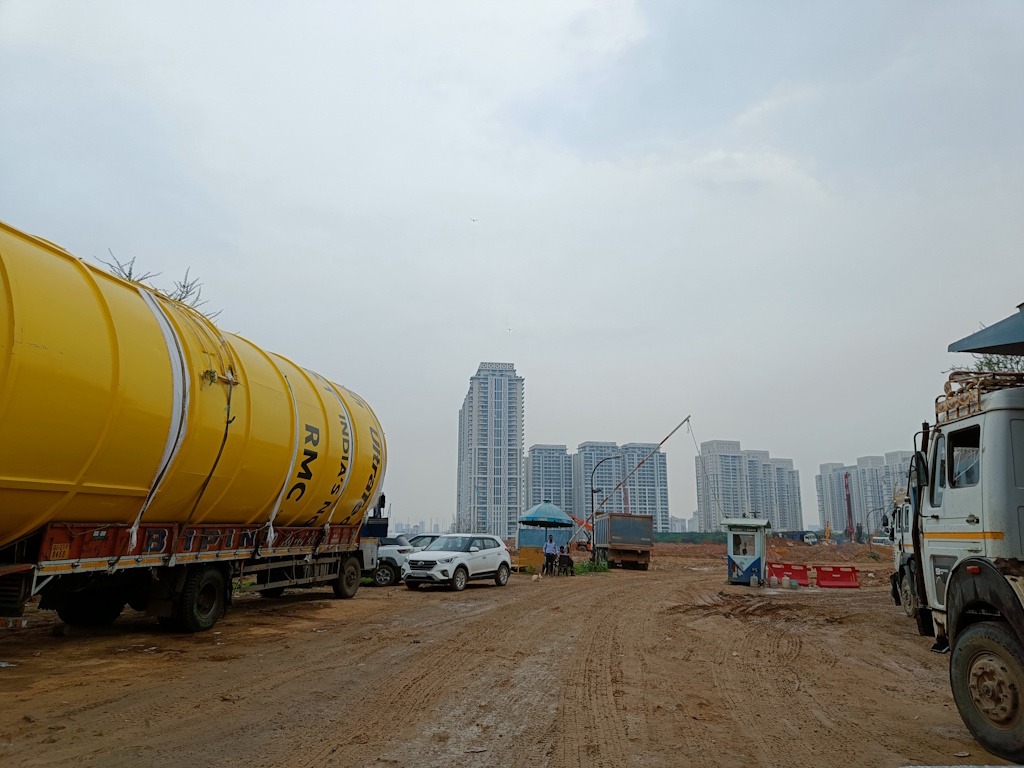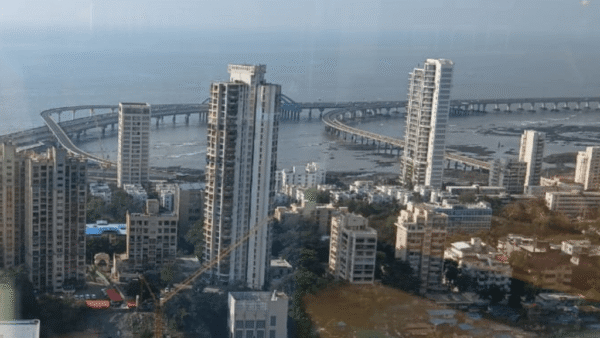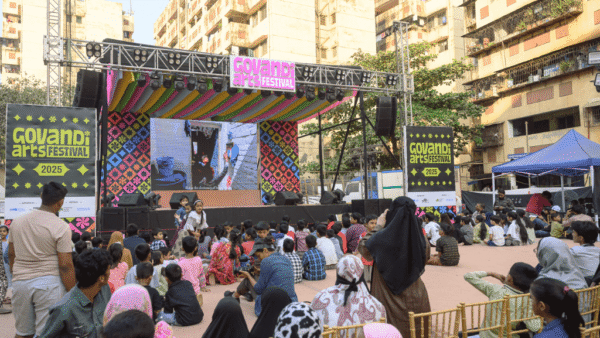On September 1st, it took just four hours of rain to bring the glam and glitzy Gurgaon to a standstill.[1] Traffic crawled for upto six hours, expensive cars bobbed on flooded streets, uber luxury apartments were inundated, people waded through knee-deep water, a human-traffic jam[2] ensued at Sikanderpur metro station, and a man even hoisted his scooter[3] on his shoulder to beat the traffic. Golf Course Road[4] — one of the city’s most expensive stretches — lay submerged. Those with a voice – Gurgaon has many such – took to the social media to blame[5] the ruling BJP government for the city crumbling.
This monsoon may have been particularly harsh but the story repeats every year. Summers are no better with unbearably high heat levels and the air pollution in winter is severe. Despite its well-appointed apartments in posh enclaves and carefully created corporate precincts, which together were to attract the crème of the upper-middle class and the wealthy, Gurgaon (officially named Gurugram) today is nothing like the future[6] of Indian urbanisation it was promoted to be.
Residents complain of failing infrastructure – bad roads, poor public transport, traffic jams, dysfunctional waste system which required foreign nationals recently to lead cleanliness drives,[7] contaminated water, declining groundwater levels, untreated toxic waste from its landfills poisoning[8] the Aravalis, water bodies reduced to garbage heaps.[9] A resident fumed[10] on social media that the authorities had sorely failed to provide the basics of city-making. “We have crazy waterlogging because nobody thought of making drainage while they were building one of the most expensive cities in the country,” she commented.
The high-rise dwellers are more vocal and visible but they are not the only ones affected. Thousands of migrant workers and long-time basti dwellers, who lived here years before the gleaming high-rise city rose, still struggle for basic amenities. While the high-rises can insulate themselves up to a point but have to interact with the public amenities outside their gates, the marginalised are forced to confront them all the time – the lack of public transport means they spend more or travel longer hours, lack of public healthcare and education impacts their families, lack of open spaces mean negligible recreation leading to physical and mental health setbacks.

Photo: Ankita Dhar Karmakar
So, what went wrong in India’s forays into building a “global city”?[11] Importantly, what lessons does it hold as turbo-charged urbanisation by private interests reshape land-use and development while governments and public authorities across the country take the backseat?
The story of Gurgaon is, at once, complex and simple – cities cannot be created by private capital alone and the state cannot merely acquire land, hand it over to private entities, and collect taxes. Cities are made collectively by the state, private interests, and all the people who occupy them.
How Gurgaon was built
The city began to take shape in the 1970s when it was a cluster of villages. Faridabad, nearby, was the industrial heart of Haryana. Gurgaon, by contrast, had little to show. Delhi, the crowded national capital, expanded to its outskirts which meant Faridabad in Haryana and NOIDA in Uttar Pradesh. The latter, with a more discernible state presence in public services, is better off when it floods. Researchers say proper planning with roads and drainage networks were done across sectors in NOIDA; it was developed on “new, undeveloped land with common infrastructure first,” PSN Rao, Professor of Housing, School of Planning and Architecture, Delhi, told The Indian Express.[12]
Gurgaon, then almost exclusively agricultural with some wasteland in between, served two purposes. It could become Delhi’s satellite city. And it could offer major private players a way out of the construction logjam in the capital after the Delhi Development Authority (DDA) monopolised land supply and squeezed out private developers. By the late 1970s, Delhi had become effectively closed to private real estate.
The then Haryana government relaxed land laws, scrapped requirements and created new rules that allowed private developers to acquire farmland and build townships. Private developers like Delhi Land and Finance (DLF), Ansal Housing, Raheja became instrumental[13] in creating the city. This, in their imaginations, meant gleaming office towers and gated enclaves, prosperous little islands of self-sufficient aspirational living. The fact that there was no municipal authority in place (until 2008), allowed developers to imagine the city on their own terms, write[14] urban researchers Shruti Rajagopalan and Alexander Tabarrok.
The Haryana government scrapped the cumbersome Non-Agricultural Use Clearance (NAC) requirement, the Haryana Urban Development Authority Act of 1977 empowered the state to acquire farmland for township development, and the Haryana Development and Regulation of Urban Areas Act (1975) licensed private developers to build on these land parcels. The former chairperson of DLF, KP Singh, has stated earlier that if these advantages had not been provided,[15] the multinational companies would not have come to Gurgaon.
The transformation was monumental. In 1991, the district’s urban population stood at just over a lakh; by 2011, it crossed 15 lakh. Currently, Gurgaon has close to 24 lakh[16] people. By the early 2010s, Gurgaon had become home to the Indian headquarters of dozens of multinationals like American Express, Google, and Microsoft to name a few. Nearly half the Fortune 500 had a presence[17] in the city. Gurgaon is now home to some of India’s most expensive housing complexes like DLF Camellias, Verandas, and the towers of Golf Course Road.
However, what was missing, by design or default, was the government’s role in building the city. While enabling private development, it appears to have stepped back from its responsibility in drawing up a comprehensive plan, providing basic infrastructure, and integrating the public and private parts of the city. During his tenure, former chief minister Manohar Lal Khattar suggested that the Gurgaon model[18] could be replicated across Haryana. The current government has doubled down with the Global City project.[19] The state has not learned its own lesson.
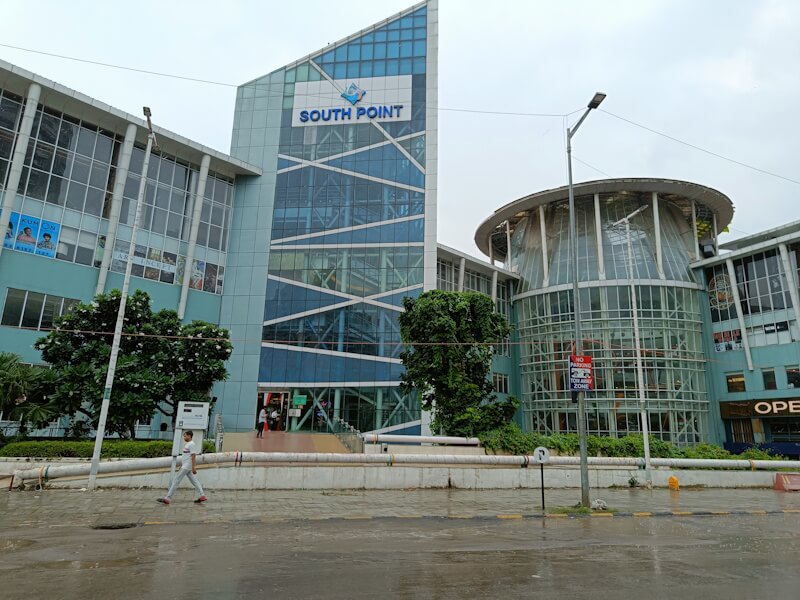
Photo: Ankita Dhar Karmakar
An unsustainable model
The state government’s negligence of or under-investment in public goods such as buses, hospitals, and affordable housing has put a burden on Gurgaon as a whole and most acutely on those who keep the city running. These Gurgaon stories rarely make it to the headlines or the social media.
Sarjeena Bibi, 30, a domestic worker, lives in Gurgaon’s Chakkarpur basti, a settlement in Sector 28 with a predominance of Bengali-Muslim migrant workers. To reach her workplace, homes in the high-rises of Sector 27, she leaves home at 5am and walks nearly half an hour each day and returns in the evening. She, like thousands, bears the cost of no reliable public transport. On heavy rainy days too, she trudges. “Khub brishti hocche tobuo aastheyi hobe. Chutti nile, chutti’r poisha kate” (Even if it rains heavily, I must go to work. Otherwise, they cut my salary). The city’s metro system is useless to her – the stations are too far and the fares too high.
A cycle would have helped Sarjeena but Gurgaon’s streets are not cyclable or even walkable.[20] There are barely any footpaths.[21] “The roads are only for vehicles, there is no walking infrastructure”, says Sarika Panda, a founding member of Raahgiri Foundation,[22] which has long campaigned for sustainable urban infrastructure in Gurgaon to make it an accessible and equitable city. Its events like car-free day push the point.
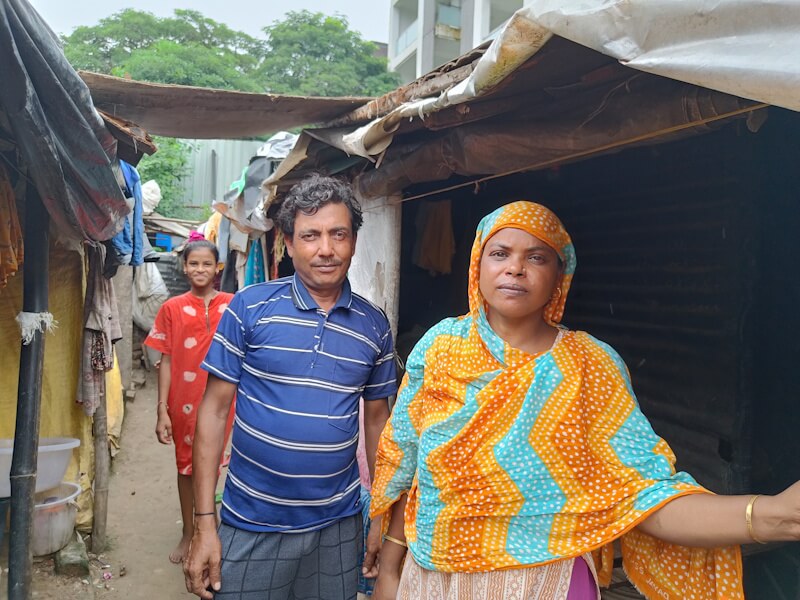
Photo: Ankita Dhar Karmakar
The lack of walking infrastructure including an absence of intersections carries risks, as Mitali Nikore, economist and policy specialist, and a resident of a high-rise on Golf Course Road, realised. “This is one of the most expensive roads in Gurgaon but terribly designed. It actively disincentivises walking, it’s only designed for the elite car-users,” she says. Also leading a research group, Nikore suggested that the Residents Welfare Association run shuttle services to their workers’ homes but the idea was dismissed.
Reliable and safe public transport has no alternative in city-making. Currently, Gurgaon has a fleet[23] of 150 buses on 24 routes but these are insufficient and there are routine breakdowns.[24] There are plans to add more[25] buses to the fleet; its Metropolitan Development Authority (GMDA) mobility management plan for 2026 projected[26] that the city needs at least 1,500 buses. There are also plans for phase 2 of the Gurgaon metro.[27] But it does not help any resident now.
The under-investment extends in healthcare too. The Civil Hospital in Sector 10, the city’s main public hospital remains[28] under-funded and over-burdened. Three years ago, when a tumor developed in Sarjeena’s throat, she first went to Delhi’s hospitals and then the Civil Hospital. “Ghure ghure kagoj potro banate parinei, ekhane ghuro okhane ghuro” (They kept sending us from one counter to another), says Alam, her husband. Since her condition was deteriorating, they eventually decided to go to a private hospital in Sector 5.
Take housing. In 2014, residents of Prem Nagar basti also known as the chik-chataiwali basti, faced eviction by the Central Market Welfare Association (CMWA) and were asked to apply to Haryana government’s low-income housing project.[29] Residents paid Rs 8,000 as fee and applied. More than a decade later, flats have not been allotted.[30] The flats were built, then marked for demolition[31] in 2023 so the land could be sold to developers. Demolition is currently stalled.[32]
Meanwhile, residents struggle for water, electricity and toilets. “Koi suwidha nahi, flat bhi nahi mila, koi sunwai bhi nahi horahi hain. Yaha ke dukandar kehte hain yaha se chale jao. Yahaan se hatke kahan jayenge? (We have access to no amenities, haven’t been allotted flats, and no one listens to us. The market people ask us to move out but where will we go,” asks a resident.
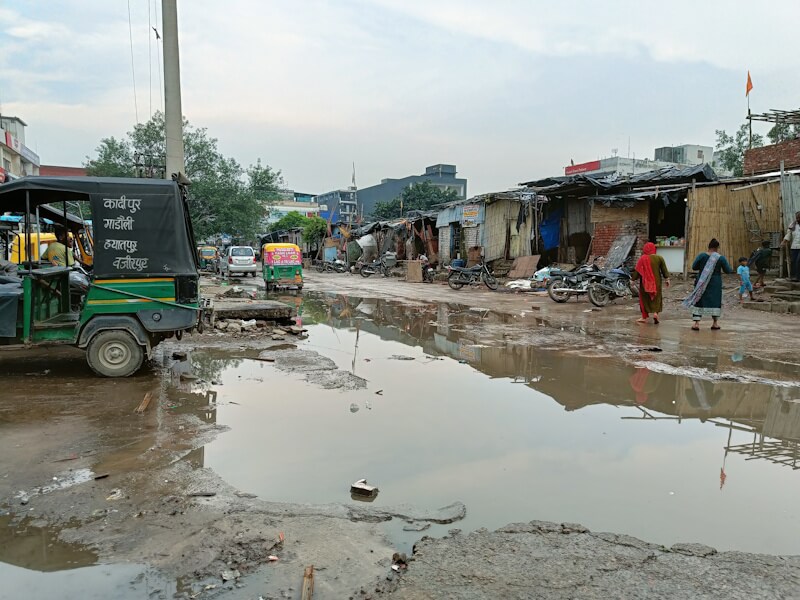
Photo: Ankita Dhar Karmakar
The residents of the luxury condominiums across Golf Course Road too have a litany of complaints. Sonia Nikore, secretary of the RWA, shares how the Municipal Corporation of Gurugram had not collected waste in her complex for the last two months which forced residents to devise their own waste management system. The complaints of traffic congestion and flooding have become legendary.
The larger flaw is the imagination
The everyday breakdowns for all in Gurgaon, the poor negotiate more of them than others, point to a larger design flaw for historian and urban scholar Professor Veena Talwar Oldenburg. Also the author of Gurgaon: From Mythic Village to Millenium City,[33] she draws on iconic novelist Salman Rushdie’s remark on Pakistan – “a place insufficiently imagined” – to argue that Gurgaon suffers from the same fate.
“There was no vision to plan a city which was not just another extension to South Delhi. The opportunity to build a city of modern India was lost entirely, buried under greed, pressures, and bribes. It became a free-for-all for the private and the public sector. I can’t blame one or the other; I blame both,” she told Question of Cities, “Their collaboration has been fatal. The average citizen is left at the mercy of whatever exists today. And Gurgaon is now painfully expensive.”
Across the Global South,[34] the rise of private cities has become a defining trend.[35] Examples include Prospera in Honduras, Waterfall City in South Africa, Phu My Hung in Vietnam, and Eko Atlantic in Nigeria. These emerged in context[36] of weak municipal governments, institutional constraints, and rapid rural-to-urban migration. A vacuum in which private developers built and governed entire urban districts. Gurgaon’s growth is somewhat similar but if this model has not delivered, what should be the way ahead?
Other roads forward
For a few like Nikore, the answer lies in doubling down on privatisation. “If you are going for private cities, the response is not to have more government,” argues Mitali and suggests that Gurgaon’s RWAs are given governing powers in the Public Private Partnership (PPP) mode.
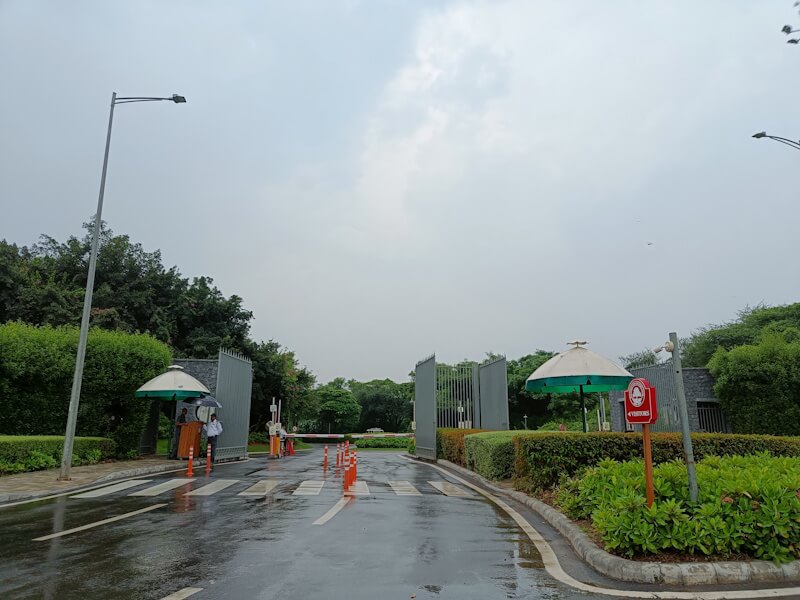
Photo: Ankita Dhar Karmakar
Others caution against seeing the private sector as the solution. “The state also needs to take ownership; in Gurgaon, it does not,” points out Nidhi Batra, urban designer and founder of Sehreeti Development Practices. She points to Chicago and New York where PPPs are structured within strong urban design guidelines and private development is balanced with public mandates. Privately-owned public spaces where developers are required to leave open areas for public use in return for planning incentives are an example. “Such smaller measures ensure private development is more inclusive,” she argues.
It’s a balance that Oldenburg, who splits her time between New York and Gurgaon, has seen play out firsthand. “New York was built by private architects and contractors but was planned for people. I can move around the city quickly on public transport; I don’t need a car. If the same can be said about Gurgaon, life would be completely different.”
There are also examples of non-traditional PPPs that expand the imagination, explains Dr Lalitha Kamath, professor in the Centre for Urban Policy & Governance at Tata Institute of Social Sciences (TISS), Mumbai. She cites the example[37] of Pune’s waste-pickers’ union Kagad Kach Patra Kashtkari Panchayat (KKPKP) which evolved into a cooperative that now manages door-to-door waste collection with municipal support. This model recognised waste-pickers as uniformed service providers working with dignity. Similar experiments have begun in Gurgaon. The Raahgiri Foundation partnered with Nagarro and Maruti Suzuki India, and municipal agencies, to design the model road[38] which has cycle tracks, footpaths, and safe crossings to “reclaim the streets for everyone”.

Photo: Sarika Panda
Underlying the privatisation, Dr Kamath argues, is a distorted way of measuring efficiency in terms of profit-loss. “This ignores the real question: What public service is provided and how essential it is to the well-being of the majority of citizens,” she points out. She points to Mumbai’s public bus system, BEST,[39] which is constantly labelled as “loss-making” but should be evaluated on metrics such as how many people it moves, how much congestion it reduces, how much carbon it saves compared to private cars.
What this points to is that the role of the state, the public authorities, in making and running a city is unique and irreplaceable. The way forward for Gurgaon is for its authorities to play their part and, and for other cities, to not repeat the Gurgaon story.
Ankita Dhar Karmakar, Multimedia Journalist and Social Media in-charge in Question of Cities, has reported and written at the intersection of gender, cities, and human rights, among other themes. Her work has been featured in several digital publications, national and international. She is the recipient of the 4th South Asia Laadli Media & Advertising Award For Gender Sensitivity and the 14th Laadli Media & Advertising Award For Gender Sensitivity. She holds a Master’s degree in English Literature from Ambedkar University, New Delhi.
Cover photo: Ankita Dhar Karmakar

